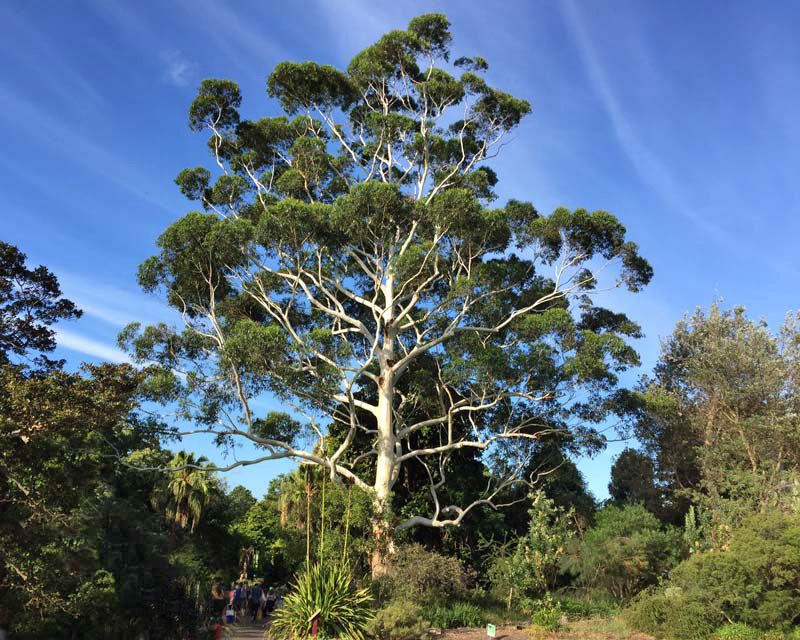- About Us
- Our Work
- Tree Info
- Get Involved
- Blog
- Volunteer
- Support Us
By Canopy Team on April 20, 2020

Eucalyptus grandis photo via Sydney Botanical Gardens
Tree Spotlight Series: Follow along as we learn about the fascinating trees that live among us. This series is in partnership with Rhee Lab in the Plant Biology Department of the Carnegie Institution for Science.
Other posts in the series: ginkgo biloba, Douglas fir, giant sequoia, Chinese tallow, silver-dollar gum, Monterey pine, green dracaena, coast live oak, cork oak, Japanese maple, silver birch, dawn redwood, Japanese persimmon ‘Hachiya’, carob, California bay, avocado, southern magnolia, flowering dogwood, red ironbark eucalyptus, blackwood acacia, narrow leaved paperbark, cockspur coral, Chinese pistache, California pepper tree, toyon, Italian cypress, strawberry tree, and European hackberry.
Eucalyptus grandis is often called the “flooded gum tree” because the bark at its base is dark in contrast with the white upper bark, resembling the debris line following a flood. It is also referred to as the “rose gum” because of the bright pink color of its heartwood. Reaching up to fifteen stories tall at the peak of maturity, E. grandis stands tall and proud as a tree of economic and environmental significance.
From house frames to furniture and boats, timber from the flooded gum tree is often used for a variety of applications. Its timber is valued for its straight grain and durability—properties that make it a popular choice. In addition, the slender yet thick-walled fiber of the pulpwood make it suitable for creating fine, high quality papers. The pulpwood is also used for tissue papers; the fiber is low in coarseness yet relatively dense.
As a reflection of its high demand, E. grandis is grown extensively in plantations in South Africa, Brazil, and Australia. In fact, E. grandis is among one of the most commercially planted eucalyptus species. About 80,000 hectares (equivalent to 150,000 football fields) are dedicated to growing E. grandis in Uruguay, where most of the lumber is processed in sawmills and pulp mills. In fact, the flooded gum tree is so high in demand that the total global acreage reaches beyond 1.3 million acres (equivalent to 1 million football fields).
Recently, a team at Macquarie University discovered that E. grandis trees in Australia can “remember” past exposure to extreme heat. After exposing E. grandis seedlings to a lab-simulated 42 degrees Celcius heatwave for four days, the team found that seedlings whose parents come from areas with longer periods of extreme heat produced higher levels of stress proteins.
The correlation between stress protein production and parental heat exposure suggest that the trees carry a form of ‘molecular memory’ for extreme conditions. These findings can be significant for restoration efforts, as this can help pinpoint the best seeds for climate-proofing forestry.
The presence of eucalyptus trees can also bring about changes to the surrounding environment. For example, eucalyptus trees have certain characteristics that can pose as fire hazards. Their rapid shedding of foliage and bark create piles of combustible material on the ground, and the trees release an ignitable aromatic substance.
In fact, the ignition of eucalyptus trees was largely responsible for the Oakland firestorm of 1991, a historic conflagration that destroyed over 1,500 acres of land and resulted in an economic loss of $1.5 billion. On the other hand, the microclimate surrounding the tree can become cooler as a result of shading and leaf litter. Deep inside a eucalyptus grove, temperatures become more moderate and light intensity dimmer.
The high tree density also creates a wetter understory—though rainfall decreases, fog-drip increases greatly. This abundance of moisture is beneficial for fire prevention, especially considering the flammable characteristics of the tree. With its important environmental and economic roles, the flooded gum tree will continue to be a tree of great interest and impact.

David Hoang was a 2019 summer intern at the Rhee Lab in the Plant Biology Department of the Carnegie Institution for Science. He is as undergraduate student majoring in bioengineering at the University of California San Diego. In his free time, he enjoys listening to podcasts and practicing photography.